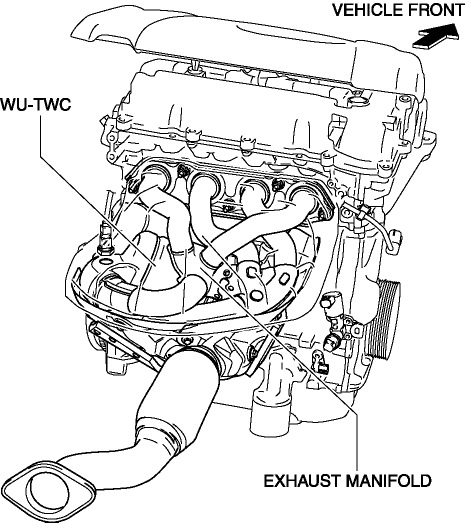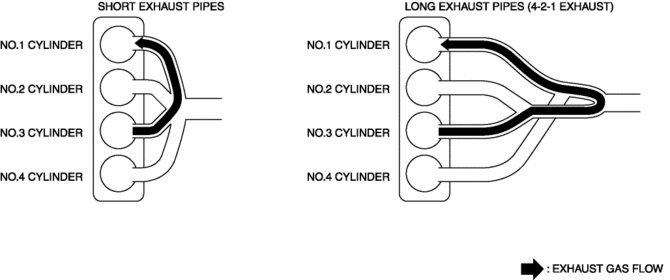Mazda CX-5 Service & Repair Manual: Exhaust Manifold
Purpose, Function
-
By lengthening the exhaust passage, the transmission of exhaust pressure waves to other cylinders can be delayed, and the amount of gas exhausted from a cylinder and forced back inside the combustion chamber is reduced By reducing the residual gas, the temperature inside the combustion chamber is reduced and the occurrence of knocking even at a high compression ratio is inhibited.
Construction
-
The exhaust manifold is installed to the rear of the engine. In addition, the catalytic converter (WU-TWC) is integrated (WU-TWC).

-
When the No.1 cylinder is at the intake stroke, the No.3 cylinder is at the exhaust stroke. By inducing the high temperature gas exhausted from the No.3 cylinder into the No.1 cylinder, the high temperature gas in the No.1 cylinder remains. If the amount of residual gas is high, the temperature in the combustion chamber rises and knocking can easily occur. With the 4-2-1 exhaust system, the transmission of exhaust pressure waves between each cylinder is delayed by the long exhaust pipes.

 Exhaust System Removal/Installation
Exhaust System Removal/Installation
WARNING:
A hot engine and exhaust system can cause severe burns. Turn off the engine
and wait until they are cool before removing the exhaust system.
2WD
1. Disconnect the negative b ...
Other materials:
Brake Pedal
Purpose/Function
An intrusion-minimizing brake pedal has been adopted to the brake pedal to
provide for a measure of safety in the event of an accident.
The intrusion-minimizing brake pedal mechanism reduces impact to the lower
extremities of the driver by minimizing the amount ...
Rear Side Panel Installation [Panel Replacement]
Symbol Mark
Installation Procedure
1. When installing new parts, measure and adjust the body as necessary to conform
with standard dimensions.
2. Drill holes for the plug welding before installing the new parts.
3. After temporarily installing new parts, make sure the related parts fit p ...
Antenna Feeder No.1 Removal/Installation
With audio system
1. Disconnect the negative battery cable..
2. Remove the following parts:
a. Side speaker grille (RH).
b. Tweeter (RH).
c. A-pillar trim.
d. Passenger-side front scuff plate.
e. Passenger-side front side trim.
f. Glove compartment.
g. Decoration panel.
h. Dashboa ...

